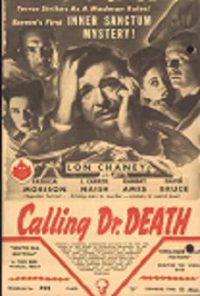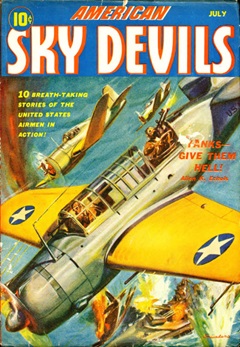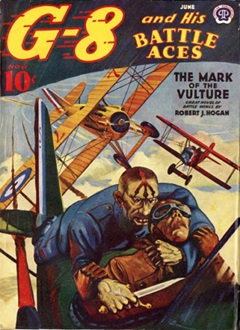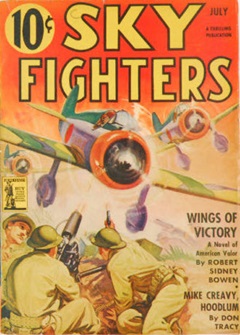
 Inner Sanctum (1941-52) aired “Terrible Vengeance” on Sunday, June 14, 1942 as the 76th of its approximately 527 episodes. Unfortunately, most of the shows are lost, with best guesstimates ranging from 140 to “less than 200” still in circulation. However, among these still existing shows, some are only partial episodes, with the majority of the complete episodes being AFRS (Armed Forces Radio Service) repeats. While the AFRS is to be commended for having preserved these episodes, it should be noted that it deleted the local, syndicated commercials in order not to play favorites with advertised products (and in select episodes added government ads supporting the war effort). It also removed the original openings and closings, running episodes under the Mystery Playhouse title with Peter Lorre as one of the show’s hosts (along with a nameless “Sergeant X” in certain episodes). This is not one of the AFRS Mystery Playhouse episodes (though the Lipton Tea commercials featuring Mary Bennett have been removed), and is otherwise a full, original episode. It features Raymond Johnson (1911-2001, photo top right) as the host. Paul McGrath {1904-1978} would replace Johnson as host after he left the show in May of 1945 to join the armed forces. Lipton Tea would not become a sponsor until the 1945 season, bringing with it the perky co-host and Lipton Tea spokesperson Mary Bennett who became famous for working in Lipton Tea commercials alongside the host’s terrible puns. Bromo Seltzer became the show’s new sponsor in July of 1946 and remained so until 1950, at which time Mars Candy Bars would assume sponsorship of the show until 1952.
Inner Sanctum (1941-52) aired “Terrible Vengeance” on Sunday, June 14, 1942 as the 76th of its approximately 527 episodes. Unfortunately, most of the shows are lost, with best guesstimates ranging from 140 to “less than 200” still in circulation. However, among these still existing shows, some are only partial episodes, with the majority of the complete episodes being AFRS (Armed Forces Radio Service) repeats. While the AFRS is to be commended for having preserved these episodes, it should be noted that it deleted the local, syndicated commercials in order not to play favorites with advertised products (and in select episodes added government ads supporting the war effort). It also removed the original openings and closings, running episodes under the Mystery Playhouse title with Peter Lorre as one of the show’s hosts (along with a nameless “Sergeant X” in certain episodes). This is not one of the AFRS Mystery Playhouse episodes (though the Lipton Tea commercials featuring Mary Bennett have been removed), and is otherwise a full, original episode. It features Raymond Johnson (1911-2001, photo top right) as the host. Paul McGrath {1904-1978} would replace Johnson as host after he left the show in May of 1945 to join the armed forces. Lipton Tea would not become a sponsor until the 1945 season, bringing with it the perky co-host and Lipton Tea spokesperson Mary Bennett who became famous for working in Lipton Tea commercials alongside the host’s terrible puns. Bromo Seltzer became the show’s new sponsor in July of 1946 and remained so until 1950, at which time Mars Candy Bars would assume sponsorship of the show until 1952.
 This is the 34th Inner Sanctum episode we’ve run since we began featuring Old Time Radio shows back in 2009. The 33rd ran in April of this year, with the 32nd in January of 2022, and the one previous to that in October of 2019 five years ago, so we felt it high time for another though it’s been a scarce 6 months since the last one, but with Halloween drawing near we wanted to offer a new one as a run up to next week’s Halloween episode. First, however, and of interest to genre fans of horror and the fantastic, we would like to note that between 1943 and 1945 Universal Pictures obtained the rights to, and produced six Inner Sanctum Mystery films. They were Calling Dr. Death (1943), Weird Woman (1944), Dead Man’s Eyes (1944), The Frozen Ghost (1945), Strange Confession (1945) and Pillow of Death (1945). All would star legendary horror actor Lon Chaney, Jr.
This is the 34th Inner Sanctum episode we’ve run since we began featuring Old Time Radio shows back in 2009. The 33rd ran in April of this year, with the 32nd in January of 2022, and the one previous to that in October of 2019 five years ago, so we felt it high time for another though it’s been a scarce 6 months since the last one, but with Halloween drawing near we wanted to offer a new one as a run up to next week’s Halloween episode. First, however, and of interest to genre fans of horror and the fantastic, we would like to note that between 1943 and 1945 Universal Pictures obtained the rights to, and produced six Inner Sanctum Mystery films. They were Calling Dr. Death (1943), Weird Woman (1944), Dead Man’s Eyes (1944), The Frozen Ghost (1945), Strange Confession (1945) and Pillow of Death (1945). All would star legendary horror actor Lon Chaney, Jr.
“Terrible Vengeance” takes us to war torn, Nazi occupied Czechoslovakia less than a year after the United States has declared war on Germany (December 11, 1941), when Europe, and especially Czechoslovakia was being ruthlessly smothered under the iron-grip of Hitler’s forces, where death had become an all too common everyday reality. The story centers on a British husband and his Czech wife who are members of the underground resistance along with a few of their fellow freedom fighters. They have undertaken what some consider a mad plan, a dangerous scheme to assassinate a local Nazi colonel, a bloodthirsty animal who has vowed to exterminate them and who has more than earned his whispered title as the “mad butcher” and “angel of death.” What their plan entails and the obstacles they must overcome—along with the eventual outcome—are at times starkly brutal and unforgiving, and for a few very young listeners may not be suitable, as this is a branch of horror brought directly into the homes of Americans newly at war, that being the horror of war quite removed from the more recognized supernatural manifestations like ghosts, goblins, vampires, witches, and werewolves. So steel yourselves for a life or death journey undertaken by a few brave souls half a world away against overwhelming odds, and see if you agree if the sacrifices they are forced to make for their freedom are worth the payoff of the “Terrible Vengeance” they feel they’ve earned the right to exact and is justified, even against someone they feel to be more animal than human.
Play Time: 25:14
{Airing on a Sunday night in the middle of June 1942, “Terrible Vengeance” gave the neighborhood gang an unexpected kind of adrenaline rush, one somewhat unfamiliar but which they understood and tried to embrace as part of their world now at war, brought to life through the medium of radio. As such, their visit to the nearby newsstand after school the next day saw them searching for material quite different than their customary detective, science fiction, or fantasy magazines. American Sky Devils (1942-43) was a new magazine, the July 1942 issue below being its first bi-monthly issue, and with its action-oriented cover was enough to catch the eye of one of the gang. Unfortunately, the magazine lasted but 6 issues, the last being the July 1943 issue. G-8 and His Battle Aces (1933-1944) was originally titled simply Battle Aces from 1930 until October of 1933. Then something took place changing not only the title to G-8 and His Battle Aces from that October 1933 issue to its final issue in June of 1944 (107 total issues), but the nature of the publication itself. The story is a fascinating one, too long to tell here, but know only that for the next 11 years from that October 1933 issue all stories were penned by one Robert J. Hogan (1897-1963). Hogan knew his stuff, being an aviator instructor after the WWI armistice and his discharge from the service. He easily convinced a friend to let him pen a series of adventures dealing with the war in the air during WWI. It was a marvelous success and Hogan would pen a full novel in each issue for 11 years (under his own name and not a publishing house pen name as was the case with both The Shadow and Doc Savage pulps which more than a single author would write), with the vast majority being for the magazine’s monthly schedule which lasted until mid-1941, at which time it became a bi-monthly for the duration of its run. Sky Fighters (1932-1950) began as a monthly for 5 years, then switched to a steady bi-monthly for 7 years, finally settling into a quarterly schedule for another 7 years, calling it a day with its single Spring 1950 issue. Though its publication schedule was gradually shaved from monthly to quarterly it must have obviously been doing something right to have successfully entertained its faithful audience for 18 years. It was a bi-monthly in 1942.}
[Left: American Sky Devils, 7/42 – Center: G-8 & His Battle Aces, 6/42 – Right: Sky Fighters, 7/42]



To view the entire list of weekly Old Time Radio episodes at Tangent Online, click here.